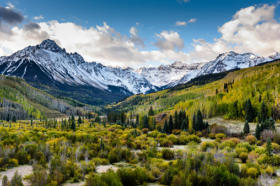The limits of bacterial hitchhiking
Posted on August 22, 2012 by Rachel Roberts, University of Reading
Bacteria are able to move across oceans, deserts and mountain ranges with relative ease, by hitching a ride in clouds of dust or water vapour. The rules that govern the dispersal, or ‘biogeography’, of larger organisms simply don’t apply to bacteria because they’re so small. So how do we know where they came from? And how do we know if a bacterial strain found in Alaska is the same as one found in Costa Rica?

A study published in the August issue of Microbiology has shed light on the dispersal of nitrogen-fixing rhizobia bacteria in North and Central America. By sequencing portions of six common genes from Bradyrhizobium strains, researchers at the State University of New York, Binghamton were able to compile phylogenetic trees which show how different strains are related to each other. Those that group together are likely to have evolved from a common ancestor.
The team found no evidence that any Bradyrhizobium strains had evolved from a common ancestor in any one region, but that the same strains were found simultaneously across North America. However, they also found that each location had its own distinctive population composition, suggesting some adaptation of each rhizobium to its environment and its legume host.
There was a trend towards higher diversity in genes from rhizobia in tropical regions: strains isolated from Panama had a significantly higher diversity than those from Washington State. This was not due to the number of legume hosts sampled in the study, or the considerably higher annual rainfall in lower latitudes. Of the genes analysed, nifD, which codes for an enzyme involved in nitrogen fixation, tended to have the greatest nucleotide diversity – double that of the other five genes.
One of the most surprising findings was the lack of community structure overlap in regions with similar characteristics, e.g. Washington State and the north-eastern US, yet overlap existed between dissimilar regions, e.g. north-eastern US and Chihuahua, Mexico. The two latter sites have distinct biotic communities (lowland temperate forest vs. mountainous evergreen oak-pine forest) with no common legume host species. However, previous studies have shown that these regions shared the same flora in the late Miocene era, which suggests the similarity may be a legacy of previous interactions.
The biogeography of legumes is affected by soil type, rainfall and temperature, meaning their distribution is not random. The dispersal of rhizobia, as symbionts of legumes, will be limited by these same factors, though perhaps not for the same reasons. The presence of rhizobia and legumes may also be limiting factors for each other.
This study provides some important insights into the biogeography of rhizobia, and emphasises a frustrating question in legume-rhizobia research: is legume distribution limited by rhizobia presence, or vice versa?
